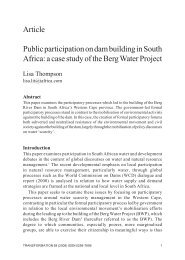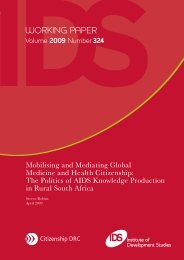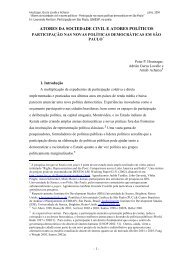Associations and the Exercise of Democratic ... - Citizenship DRC
Associations and the Exercise of Democratic ... - Citizenship DRC
Associations and the Exercise of Democratic ... - Citizenship DRC
You also want an ePaper? Increase the reach of your titles
YUMPU automatically turns print PDFs into web optimized ePapers that Google loves.
IDS WORKING PAPER 285informal relations, <strong>and</strong> public sector workers have <strong>the</strong> highest participation rates.The consequences <strong>of</strong> this distribution are starker for São Paulo, which has both alarger share <strong>of</strong> workers in informal employment <strong>and</strong> a smaller public sector). 35Summarising, associational participation is far more stratified than citizenship activity.Direct relations to government are, in turn, considerably more stratified than o<strong>the</strong>rforms <strong>of</strong> civil relations to government. The sharp stratification <strong>of</strong> associationalparticipation suggests that any citizenship gains from participation in associationswill be distributed unevenly across <strong>the</strong> population.4.4 Associational participation <strong>and</strong> citizenshipIs <strong>the</strong>re a correlation between participation in associations <strong>and</strong> active citizenship,<strong>and</strong> to <strong>the</strong> desirable direct civil relations to government in particular? To answer inpurely descriptive terms we leave aside for now concerns about <strong>the</strong> direction <strong>of</strong>causality <strong>and</strong> possible selection biases (addressed below). The share <strong>of</strong> <strong>the</strong> populationin <strong>the</strong> two cities that participate in associations <strong>and</strong> are active citizens is 17 per centin São Paulo <strong>and</strong> 24.4 per cent in Mexico City. Because about a third <strong>of</strong> <strong>the</strong>population in both cities participates in associations, <strong>the</strong> higher percentage inMexico City reflects <strong>the</strong> larger share <strong>of</strong> <strong>the</strong> population that is active in that city.We find that individuals who participate in associations are more likely to be activecitizens than <strong>the</strong>ir counterparts without such participation. In São Paulo, an individualwho participates in <strong>the</strong> activities <strong>of</strong> associations is twice as likely to be an active citizenas those who do not, whereas in Mexico City <strong>the</strong> likelihood increases by 50 per cent.The correlation between associational participation <strong>and</strong> civil relations is <strong>the</strong>reforeparticularly strong in São Paulo. It is none<strong>the</strong>less substantial in Mexico City as well.Figure 4.3 Percentage <strong>of</strong> population that are active citizenship,with associational participation <strong>and</strong> with none35 The share in informal employment is far higher in São Paulo (50 per cent) than in MexicoCity (37 per cent), while <strong>the</strong> public sector is far smaller (4 per cent <strong>of</strong> workers) than inMexico City (19 per cent), <strong>and</strong> almost half <strong>of</strong> all workers have formal private sectoremployment in <strong>the</strong> two cities (around 45 per cent).30





